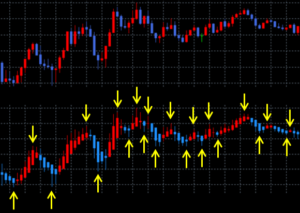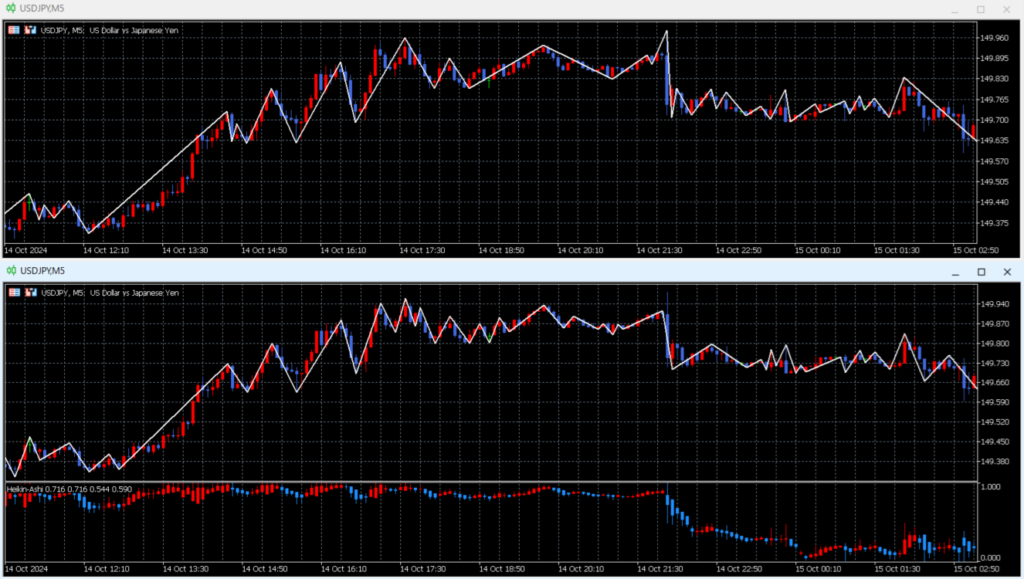目次
作るもの
以前、自分用のZigZag的なインジケータを作ってみましたが、いまいちな結果で終わってしまいました。
そこで今回は、前回とは別アプローチで波形を描いてみようと思います。
今回の高値・安値の決め方は以下のとおり。
- 平均足が陽線から陰線に切替わったら、直前の陽線群の最高値の点を追加
- 〃 陰線から陽線に 〃 、直前の陰線群の最安値の点を追加

図の矢印の高値・安値を結ぶことになります。
これで、まあまあいい感じの波形になってくれないかと期待しています。
実装
技術的に目新しいことは特にないので、ソースコード全体だけ載せます。
//+------------------------------------------------------------------+
//| ZigZaaag.mq5 |
//| Copyright 2024, Hailu |
//| https://www.mql5.com |
//+------------------------------------------------------------------+
#property copyright "Copyright 2024, Hailu"
#property link "https://www.mql5.com"
#property version "1.01"
#property indicator_chart_window
#property indicator_buffers 3
#property indicator_plots 1
#property indicator_type1 DRAW_SECTION
#property indicator_color1 clrWhiteSmoke
#property indicator_width1 2
double bufZig[];
double bufOpen[];
double bufClose[];
int hHeiken = 0;
datetime prevDt = 0;
//+------------------------------------------------------------------+
//| Custom indicator initialization function |
//+------------------------------------------------------------------+
int OnInit()
{
// 平均足インジケータを作成
hHeiken = iCustom(NULL, 0, "Examples\\Heiken_Ashi");
if (hHeiken == INVALID_HANDLE)
{
PrintFormat("[E] Failed to create Heiken_Ashi indicator. [%d]", GetLastError());
return INIT_FAILED;
}
SetIndexBuffer(0, bufZig, INDICATOR_DATA);
SetIndexBuffer(1, bufOpen, INDICATOR_CALCULATIONS);
SetIndexBuffer(2, bufClose, INDICATOR_CALCULATIONS);
PlotIndexSetDouble(0, PLOT_EMPTY_VALUE, 0.0);
prevDt = 0;
return INIT_SUCCEEDED;
}
//+------------------------------------------------------------------+
//| Custom indicator iteration function |
//+------------------------------------------------------------------+
int OnCalculate(const int rates_total,
const int prev_calculated,
const datetime &time[],
const double &open[],
const double &high[],
const double &low[],
const double &close[],
const long &tick_volume[],
const long &volume[],
const int &spread[])
{
// 平均足を取得
CopyBuffer(hHeiken, 0, 0, rates_total, bufOpen);
CopyBuffer(hHeiken, 3, 0, rates_total, bufClose);
int start = 1;
if(prev_calculated == 0)
{
bufZig[0] = 0;
}
else
{
// 直前の陽線群または陰線群の開始位置を、処理開始位置とする
int il = prev_calculated - 1;
if (bufOpen[il] >= bufClose[il])
{
for (int i = il - 1; i >= 0; i--)
{
if (bufOpen[i] < bufClose[i])
{
start = i;
break;
}
}
}
else
{
for (int i = il - 1; i >= 0; i--)
{
if (bufOpen[i] > bufClose[i])
{
start = i;
break;
}
}
}
start = MathMax(start, 1);
}
for(int i = start; i < rates_total; i++)
{
int ip = i - 1;
// 平均足が陽線から陰線に切替わった
if ((bufOpen[ip] <= bufClose[ip]) && (bufOpen[i] > bufClose[i]))
{
double h = high[ip];
bufZig[ip] = 0;
// 陽線群の最高値を検索
for (int j = i - 2; j >= 0; j--)
{
if (bufOpen[j] <= bufClose[j])
{
bufZig[j] = 0;
if (high[j] > h)
{
ip = j;
h = high[j];
}
}
else
break;
}
bufZig[ip] = h;
}
// 平均足が陰線から陽線に切替わった
else if ((bufOpen[ip] >= bufClose[ip]) && (bufOpen[i] < bufClose[i]))
{
double l = low[ip];
bufZig[ip] = 0;
// 陰線群の最安値を検索
for (int j = i - 2; j >= 0; j--)
{
if (bufOpen[j] >= bufClose[j])
{
bufZig[j] = 0;
if (low[j] < l)
{
ip = j;
l = low[j];
}
}
else
break;
}
bufZig[ip] = l;
}
}
return rates_total;
}
//+------------------------------------------------------------------+これをチャートに乗せてみると、次のようになります。

う~ん...悪くはないけど、前回とは別の部分で山・谷が多いのが気になりますね。
今回はここまで。
まあ、これを見るともう一つやってみたいことはありますね...(´-`).。oO
それではまた、アップデートし次第、記事にします。








コメント